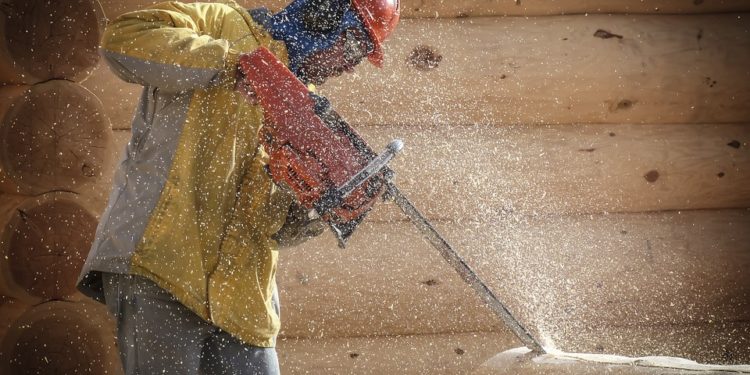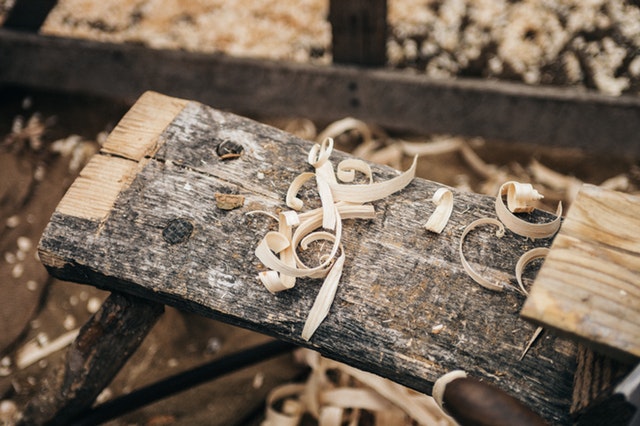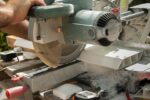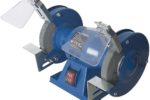The Best Chainsaw FAQs | 2023

Chainsaw FAQs
Why Was the Chainsaw Invented?
Although current-day chainsaws are synonymous with DIY jobs and tree removal, the first chainsaws were actually invented for use in a surgical context. The first chainsaws were invented in the late 1700s to assist in childbirth, providing a heavy-duty cutting tool that could remove pelvic bone quickly to allow for easier delivery of babies. However, these chainsaws looked unlike anything on the market today. They were far smaller than modern chainsaws, looking more like large culinary knives. They also made use of a hand crank in order for the cutting/sawing action to be utilised. This type of chainsaw continued to be use in surgical rooms for many decades.
It wasn’t until the 1900s that the chainsaw was redeveloped to resemble something closer to its current design. The first electric chainsaw was invented in 1905 and uses for the more conventional job of felling trees. Electric chainsaws finally became a commonplace power tool in the 1920s.
How to Sharpen a Chainsaw
Keeping your chainsaw sharp is very important. Thankfully, it is quite easy to sharpen a chainsaw yourself. To sharpen a chainsaw by hand, you will need a few tools. A round file is a must. Make sure the file you choose is a perfect match for the diameter of your chainsaw cutter. You will also need to use a file guide to keep the round file in place as you sharpen the cutter. A flat file can also be used to manually sharpen a chainsaw cutter. You will also want to invest in a depth-gauge guide. These guides will allow you easily reset the depth gauges as you sharpen your chainsaw.
How to Use a Chainsaw
In order to safely use a chainsaw, you should move it near to your cutting target prior to engaging the engine and starting it up. You should place the cutting blade against the material you are looking to cut softly, allowing the momentum of the cutting chain to take hold and begin sawing. You should never apply heavy force to a chainsaw or push it aggressively through wood. Doing so can result in kickback, or lead to your cutting blade becoming stuck. Holding the chainsaw in both hands is also crucial if you want to avoid kickback and the chance of injury.
How to Measure a Chainsaw Bar
Being able to measure a chainsaw bar accurately is essential if you ever find yourself having to replace a chain. In order to get an accurate measurement, you need to measure from the end of the top, right down to where the cutter is closest to the main housing of the chainsaw. Sometimes, this measurement will not be an even number. If you find the measurement falling short, you should always round the measurement up to the closest even number. Therefore, if your measurement comes out at 16.75 inches, you should round up to 18 inches.
How to Start a Stihl Chainsaw
Before attempting to start a Stihl chainsaw, you should first inspect the tool for any issues. If you identify any loose parts or damaged components, make sure you take care of these or replacement them before attempting to use your chainsaw. You will also need to ensure the chainsaw is properly tensioned prior to use. You may also want to sharpen your chainsaw cutter if it has been used recently. Lubricating the chainsaw bar may also be necessary. A Stihl chainsaw also needs to be fully fuelled and oiled prior to use. Next, make sure you are wearing adequate safety gear, including gloves and protective eyewear. Ear guards may also be necessary.
Now you can focus on getting your Stihl chainsaw going. First, locate the fuel bulb and push down on it a few times. Next, you will need to identify the throttle trigger and pull it, before pressing down the lock-out button. This is usually found above the handle, near to the trigger. You should then set the control switch so it is in closed throttle mode. The chainsaw should then be placed on flat ground, allowing you to activate the chain brake.
Make sure you push it forward far enough that it sets into a locked position. Then move onto the starer grip. Use one foot to keep the chainsaw held down to the ground as you pull the starter rope with the hand on the other side of your body. You may need to pull the starter several times to get your chainsaw going. However, avoiding pulling it more times than is needed as this risks flooding the engine.
How to Cut Down a Tree with a Chainsaw
Felling trees is one of the most common applications for a chainsaw. However, if you want to keep safe when cutting down trees with a chainsaw, you need to plan ahead and follow a few basic steps. Your chainsaw should be filled with enough fuel and fresh oil in order to carry out a lengthy cutting job. It should also be properly sharpened, or kitted out with a new chain. You should definitely be wearing protective gear when cutting trees down with a chainsaw, as there will be a significant amount of debris flying around at all times.
You also need to consider your surroundings. Think about the clearance you when cutting a tree down. Remove any obstacles from the vicinity that might become crushed by the falling trunk. If you can not remove certain things from your surroundings, such as flower beds and small structures, consider covering them with protective sheeting. You may also want to attach a safety line to the tree trunk, encouraging to fall in a certain direction once you have sawn through the wood. You should also ensure you have a path cleared for a quick retreat if you need to get out of the way in a hurry.
How to Start a Chainsaw
If you have yet to use a chainsaw, this type of power tool can be fairly daunting. However, operating a chainsaw is fairly easy, provided you take some basic precautions and follow a few key pointers. Firstly, make sure you are wearing some basic protective gear. Heavy-duty gloves and decent eyewear is a must. Next, you can think about starting the chainsaw. To do this, first place the chainsaw on the ground. Make sure it is lying on a flat surface. Next, lock the chain brake. You should then turn on the chainsaw choke, pushing the primer down several times. Most of the time, the primer will need around five individual pushes.
You should then place your foot through the rear handle of the chainsaw, pulling the starter rope several times. Take one hand and place it on top of the handle, leaning as you do your weight holds it in place. Your hand should be used to pull the starter rope until the chainsaw engine starts. Once the engine has started, you can begin cutting with it. Once the engine has started up, you can set the chainsaw throttle to idle. Next, you should press the trigger to move the master control switch into the run position, as well as unlock the trigger lock. Your Stihl chainsaw is now ready to go.
Who Makes the Best Chainsaw in the World?
Pretty much any major power tool brand offers chainsaws as part of their product catalogue. However, some brands have a better reputation than others. One of the most popular brands for chainsaws is Husqvarna. This brand has a solid reputation for reliable chainsaws that deliver incredible performance. However, the best chainsaw manufacturer out there is arguably Stihl. This brand is the go-to choice for professionals and those looking for heavy-duty chainsaws that can cope with frequent use and more demanding cutting tasks.
How Tight Should a Chainsaw Chain Be?
Ensuring your chainsaw chain is properly tensioned is crucial in ensuring it performs correctly. Checking the tensioning of your chainsaw chain is fairly simple. When fitted, your chainsaw chain should feel tight against the cutting blade, but not too tight. Basically you should still be able to pull the chain away from the blade fairly easily. You can also check tension levels by carrying out a snap test. To do this, pull on the section of the chain that is located beneath the guide bar, removing a couple of the links from the guide bar rails beneath. If your chain is correctly tensioned, these loose links should snap back into place quickly.
How to Tune a Chainsaw
Learning how to tune your chainsaw is important if you plan on using your power tool regularly. To tune a chainsaw, you should first start it and allow it to run for a couple of minutes as it warms up. Next, set your chainsaw carefully down on a flat surface. You should leave it idle for a minimum of 30 seconds, before picking it up and tilting it forward slightly. The bar should be tilted downwards, with the handle facing upwards. If the chainsaw stalls at this point, you should look for the low speed screw and tighten it. This should throttle the amount of fuel entering the carburettor.
Next, you should accelerate the idling saw. The chainsaw should be left to accelerate for a few seconds, although you should never let it continue to rev for anything longer than 10 seconds. As it is being revved, the chainsaw should make a fluttering sound. If it doesn’t and instead makes a loud screeching sound, you will need to find the high speed screw and loosen it. You will now if your chainsaw has been properly tuned if the chain remains stationary when the saw is idle.
How to Put a Chain on a Chainsaw
Putting a replacement chain on a chainsaw needn’t be difficult. To begin, you should make sure that the chain is laid out in the correct direction. Once you have ensured the chain is properly aligned, you can move onto adding it to the chainsaw itself. The chain should first be set around the chainsaw sprocket. Once you have done this, you should be able to correctly set the chain grooves around the length of the bar. Once the chain has been attached to the bar along the correct grooves, you should think about tensioning the chain.
How to Untangle a Chainsaw Chain
Sometimes, you will find yourself having to deal with a tangled chainsaw chain. Thankfully, untangling a chainsaw chain is quite simple. First, make some preparations. Place your chainsaw on a flat and even surface. Make sure you are wearing gloves and protective gear before you try to remove the chain. You will need to make use of your toolbox to remove the chainsaw housing, chain and bar from each other. If you are trying to untangle a fairly new chain, you need to be weary about any sharp edges. Older chains with signs of rust may be particularly stubborn, so adding some lubricating oil will help make the job easier.
To make quick work of untangling a chainsaw chain, you need to identify the two end loops of the chain. Keeping the chain anchored at these points, loosen the chain elsewhere. This may automatically untangle minor knots, but it will definitely make it much easier to work on more complex tangles. If you find yourself dealing with numerous tangles that can not be loosened, you may need to replace the chain entirely.
How to Shorten a Chainsaw Chain
Shortening a chainsaw chain is reasonably straightforward. In fact, you can do this by simply removing a single link. Before attempting to remove links from your chain, you should make sure that your chainsaw has been switched off for some time. It should have been turned off for long enough that the chain and its links are cool and comfortable to handle. You should also remove the spark plug cable to ensure the chainsaw can not operate as you are carrying out your chain adjustments.
Next, you need to identify the master link. Most chainsaws feature a master link to allow for easy removal of the chain. It should be fairly easy to locate a master link from standard links. Once the master link has been opened and removed, you can remove the closest standard link to it. You may need to use pliers in order to remove these links. Once you have done this, you should reattach the mater link to form a closed loop. Once you have removed a link to shorten the chain of your chainsaw, you will need to check the tension before using your chainsaw again.
How to Cut Wood Slices with a Chainsaw
One of the most common tasks for a chainsaw is cutting wood slices. However, in order to cut even slices with a clean edge, you need to adopt a certain technique. Firstly, make sure your chainsaw is warmed up and engaged. Next, hold the chainsaw in a firm grasp with both hands, hovering the cutting blade slightly above the wood you are looking to cut.
When you have your chainsaw blade in place, squeeze down on the throttle as you begin to lower the chainsaw blade onto the wood. Only use a slight amount of downward pressure when pushing down into the wood to make your cut. The chainsaw will do much of the work. If you push down too much, you can lose control of your chainsaw is risk getting the blade stuck in the wood.
How to Chainsaw Carve
Although fairly large, chainsaws can be effectively used for wood carving. However, you will need to be very confident with your chainsaw in order to succeed at carving. As you will be wielding your chainsaw at potentially awkward angles, you need to make sure you have the strength to hold and handle your chainsaw model. You will also need to wear heavy-duty safety gear to protect yourself from injury.
When carving with a chainsaw, you should make sure your chainsaw blade is as sharp as possible. This will allow you to make more precise cuts and carve more quickly. You should think about sharpening your chainsaw every time you come to carve wood. You may also want to use a variety of different chainsaws when carving wood.
If possible, have two or three different chainsaws to hand so you can carry out a variety of cuts in one session. Your largest chainsaw model should be used to remove big pieces of wood, while smaller chainsaws can be used to make more minor cuts and carve detailed edges. You will almost certainly need to finish your carving job with smaller handheld devices or manual tools.
What is Chainsaw Bar Oil?
Chainsaw bar oil is essential if you want your chainsaw to spin quickly and consistently. Applying bar oil to your chainsaw provides it with a slick layer that prevents friction from slowing down the spinning rate of your chain as it makes contact with other metal edges. For best results, always use the type of bar oil suggested by the manufacturer of any given chainsaw model.






